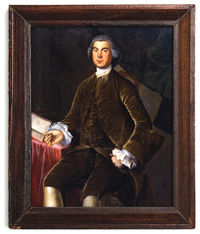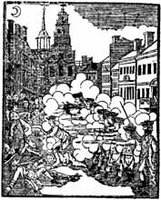A Sestercentennial Stand-Off on King Street
By publishing Customs house documents that embarrassed the Whig merchants of Boston, John Mein knew that he made himself unpopular.
In fact, a confidential informant, the painter George Mason, told Customs Collector Joseph Harrison on 20 Oct 1769 that Mein was “oblig’d to go Arm’d, and ’tis but a few Nights since that two Persons who resembled him pretty much were attack’d in a narrow Alley with Clubs, and would in all probability have lost their Lives if the Mistakes had not been timely discover’d.”
Mein’s insulting “Characters” of top Whigs, published in his Boston Chronicle newspaper on 26 October and republished in a pamphlet two days later, pushed some of those enemies over the edge. Toward the end of the day on Saturday, 28 October, Mein and his printing partner John Fleeming, were walking along King Street.
Merchant captain Samuel Dashwood (1729?-1792) confronted Mein, angry at being called “the Grunting Captain.” With him were other Whig merchants, such as William Molineux (1713?-1774), Edward Davis (1718-1784), and Duncan Ingraham (1726-1811). Two of those men were in their forties, the other two in their fifties, but they were about to behave like the twenty- and thirtysomething gentlemen who had thrust themselves into the Otis-Robinson fight the month before.
According to Mein, writing on 5 November:
Mein, pointing his pistol, backed toward the main guard near the Town House (now the Old State House). “I often told them I would shoot the first Man who touched me,” he declared. Fleeming followed. The crowd, still at a distance, grew larger. Shopkeeper and importer Elizabeth Cumings, visiting a friend on King Street, heard “a violent skreeming Kill him, kill him” outside. Mein said people were throwing things. He spotted selectman Jonathan Mason within the crowd.
The main guard was the building where the army organized its sentries and patrols, where soldiers on duty that night were gathered. As the printer approached, an officer recognized him and “desired the Centries to keep their Posts clear” of people. Those soldiers probably stepped forward and presented their bayonets. Mein began “cooly stepping up the Guardroom steps.”
Thomas Marshall (1719-1800, shown above) didn’t want to see Mein get away. He was a tailor with a shop on King Street, but he was better known in Boston as the colonel in charge of the town’s militia regiment. Mein listed Marshall among the men who had first confronted him, but it seems just as likely that he came out of his store after he heard the commotion.
The colonel grabbed “a large Iron Shovel” from the hardware shop of Daniel and Joseph Waldo, the sign of the Elephant. He slipped around the sentries and came at Mein from the rear, swinging the shovel. Mein stated, “the Blow cut thro’ my Coat & Waistcoat, and made a Wound of about two Inches long in my left Shoulder.”
And then a gun went off.
TOMORROW: Manhunt.
In fact, a confidential informant, the painter George Mason, told Customs Collector Joseph Harrison on 20 Oct 1769 that Mein was “oblig’d to go Arm’d, and ’tis but a few Nights since that two Persons who resembled him pretty much were attack’d in a narrow Alley with Clubs, and would in all probability have lost their Lives if the Mistakes had not been timely discover’d.”
Mein’s insulting “Characters” of top Whigs, published in his Boston Chronicle newspaper on 26 October and republished in a pamphlet two days later, pushed some of those enemies over the edge. Toward the end of the day on Saturday, 28 October, Mein and his printing partner John Fleeming, were walking along King Street.
Merchant captain Samuel Dashwood (1729?-1792) confronted Mein, angry at being called “the Grunting Captain.” With him were other Whig merchants, such as William Molineux (1713?-1774), Edward Davis (1718-1784), and Duncan Ingraham (1726-1811). Two of those men were in their forties, the other two in their fifties, but they were about to behave like the twenty- and thirtysomething gentlemen who had thrust themselves into the Otis-Robinson fight the month before.
According to Mein, writing on 5 November:
Davis first made a push at me with his Cane which struck me on the left side of the belly, and has left a Bloody Contussion, which now, 8 days after, still remains with great hardness all round; on being struck I immediately took a Pistol out of my Pocket, cocked, and presented it; instantly a large Circle was formedAs one would expect.
Mein, pointing his pistol, backed toward the main guard near the Town House (now the Old State House). “I often told them I would shoot the first Man who touched me,” he declared. Fleeming followed. The crowd, still at a distance, grew larger. Shopkeeper and importer Elizabeth Cumings, visiting a friend on King Street, heard “a violent skreeming Kill him, kill him” outside. Mein said people were throwing things. He spotted selectman Jonathan Mason within the crowd.
The main guard was the building where the army organized its sentries and patrols, where soldiers on duty that night were gathered. As the printer approached, an officer recognized him and “desired the Centries to keep their Posts clear” of people. Those soldiers probably stepped forward and presented their bayonets. Mein began “cooly stepping up the Guardroom steps.”
Thomas Marshall (1719-1800, shown above) didn’t want to see Mein get away. He was a tailor with a shop on King Street, but he was better known in Boston as the colonel in charge of the town’s militia regiment. Mein listed Marshall among the men who had first confronted him, but it seems just as likely that he came out of his store after he heard the commotion.
The colonel grabbed “a large Iron Shovel” from the hardware shop of Daniel and Joseph Waldo, the sign of the Elephant. He slipped around the sentries and came at Mein from the rear, swinging the shovel. Mein stated, “the Blow cut thro’ my Coat & Waistcoat, and made a Wound of about two Inches long in my left Shoulder.”
And then a gun went off.
TOMORROW: Manhunt.


